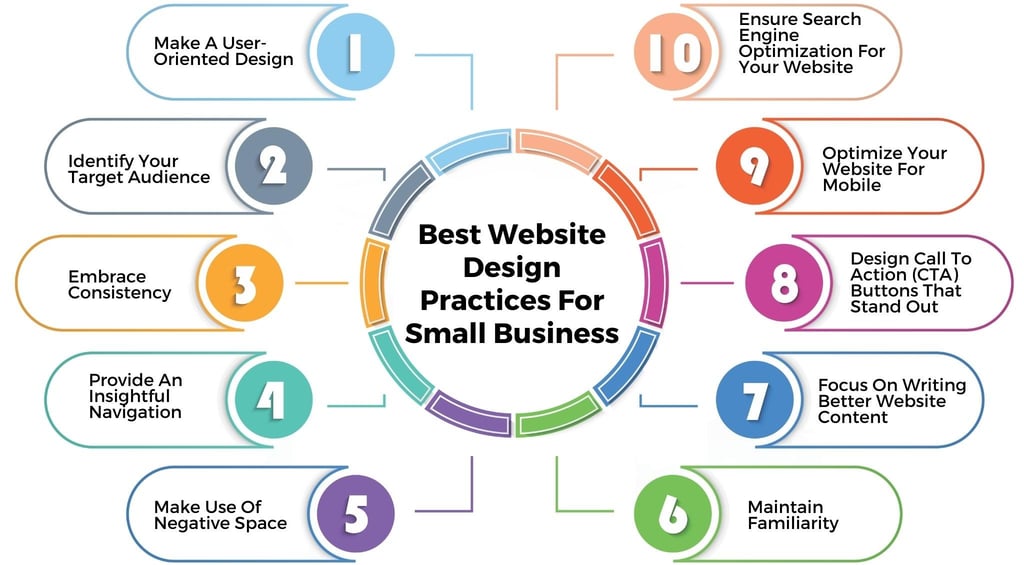Web Design Standards: The 10 Best Practices Seen on the Top 50 Websites
Discover the essential web design standards used by the world’s top 50 websites. This guide highlights the 10 best practices—covering layout, speed, mobile responsiveness, navigation, branding, accessibility, visuals, security, and CTAs—to help you build a modern, user-friendly, and high-converting website.
Mat Seo
11/17/20253 min read


Web Design Standards: The 10 Best Practices Seen on the Top 50 Websites
In today’s digital landscape, users expect fast, intuitive, and visually appealing web experiences. After analyzing design patterns from the world’s top 50 websites, several clear standards emerge. These practices help improve usability, enhance conversions, and create memorable online experiences. Below are the 10 best web design standards adopted by leading websites worldwide.
1. Clean, Minimal, and Purpose-Driven Layouts
Top-performing websites follow a minimalistic design approach—reducing clutter and focusing on key user actions.
What this includes
Ample white space to allow the eyes to rest
Clearly structured sections
Typography that is simple and easy to scan
Visual hierarchy that leads users toward desired actions (e.g., buttons, CTAs)
Why it matters
Minimalism improves readability, reduces cognitive load, and increases conversion rates. Platforms like Google, Apple, and Airbnb showcase this principle consistently.
2. Fast Loading Speeds Across All Devices
User patience is at an all-time low. Research shows that a 1-second delay can reduce conversions by up to 7%.
Top website strategies
Optimized images and lazy loading
Minified CSS, HTML, and JavaScript
Caching and CDN usage
Fast, lightweight frameworks
Why it matters
Faster websites keep users engaged and improve search engine rankings. Every major site—Amazon, YouTube, Facebook—prioritizes speed optimization.
3. Mobile-Responsive and Adaptive Design
Over 55% of global web traffic now comes from mobile devices. Top websites offer seamless experiences across all screen sizes.
Core principles
Flexible grids and fluid images
Mobile-first design approach
Thumb-friendly navigation and buttons
Collapsible menus and simplified header sections
Why it matters
Responsiveness helps retain mobile users, reduces bounce rates, and boosts SEO performance.
4. Clear and Consistent Navigation
Navigation is the backbone of user experience. The top 50 websites prioritize intuitive, predictable navigation systems.
Common patterns
Sticky headers for easy access
Search bars in prominent positions
Limited number of menu items
Simple categories and subcategories
Breadcrumbs for improved orientation
Why it matters
The easier users find information, the longer they stay. Websites like Wikipedia, Amazon, and LinkedIn excel in navigation structure.
5. Strong Visual Hierarchy and Typography
Top websites guide users using typography, color contrast, and spacing to highlight important elements.
Key practices
Larger, bolder headings
1–2 typography families used consistently
High contrast between text and background
Clear distinction between paragraphs, buttons, and banners
Why it matters
Visual hierarchy organizes content and improves user comprehension, especially on content-heavy websites.
6. Consistent Branding Across All Pages
Brand identity isn’t only about logos—it’s about a cohesive look and feel across the entire website.
Branding elements from top websites
Consistent color palettes
Repetitive UI patterns
Unified icon styles
Tone-matched copywriting
Recognizable branding in headers and footers
Why it matters
Strong branding builds trust, recognition, and emotional connection.
7. Accessibility and Inclusive Design
Top global websites follow WCAG guidelines to ensure usability for all users, including those with disabilities.
Essential accessibility practices
Alt text for images
Keyboard navigation
Screen-reader compatibility
Sufficient contrast ratios
Large buttons and clickable areas
Captioned videos
Why it matters
Accessible websites reach larger audiences, improve SEO, and align with global standards.
8. High-Quality Visual Content
The world’s top websites use visuals that communicate instantly—no guesswork.
Popular visual trends
Professional photography
Custom illustrations and icons
Light animations and transitions
Short explainer videos
SVG graphics for crisp scaling
Why it matters
Quality visuals boost engagement, reduce bounce rates, and enhance storytelling.
9. Trust-Building Elements and User Security
Since users regularly share personal and financial info online, top websites prioritize trust signals and transparency.
Key trust elements
SSL certificates (HTTPS)
Clear privacy policies
Secure login and authentication
Visible customer support options
Social proof (reviews, ratings, testimonials)
Why it matters
Users continue browsing when they feel safe. Platforms like PayPal, banks, and e-commerce leaders excel in trust-building.
10. Clear Calls-to-Action (CTAs) and Conversion Optimization
CTAs are the heart of conversions. Top websites design them to be clear, noticeable, and easy to understand.
Best CTA practices
Action-focused text (e.g., Get Started, Download Now, Buy Today)
High-contrast buttons
Strategic placement above the fold
Repetition of key CTAs on long pages
Why it matters
Strong CTAs turn visitors into subscribers, buyers, or leads—essential for business growth.
Conclusion
The top 50 global websites follow a pattern of clean design, speed, accessibility, and strategic user experience. By applying these 10 web design standards, any business can significantly improve usability, customer satisfaction, and conversion rates.
A website doesn’t need to be complicated—it needs to be efficient, consistent, and user-friendly. Following these industry-leading practices ensures your website stays competitive in today’s digital world.
Boost your online visibility with our expertise.
Contact
Links
info@matseo.com
© 2025. All rights reserved.
